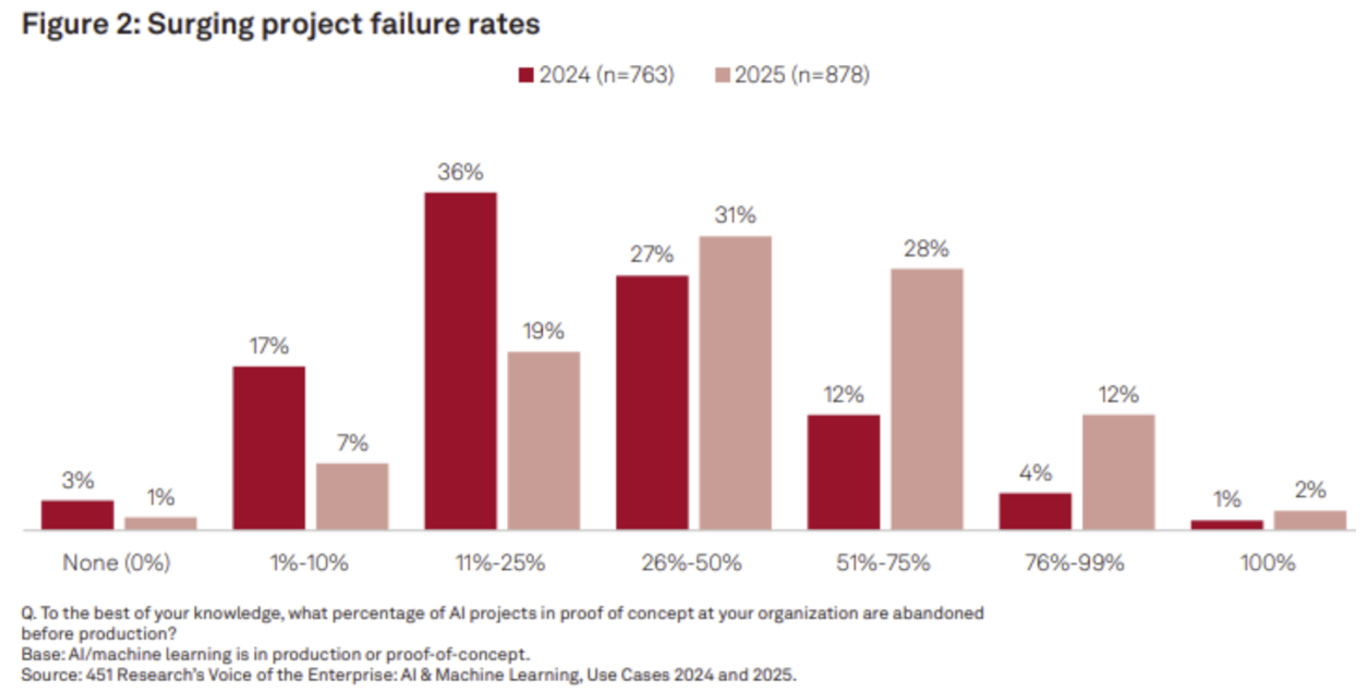Welcome to Binary Circuits’ 25th weekly edition
Your weekly guide to most important developments in technological world
Dear Readers,
Binary Circuit investigates trends, technology, and how organizations might profit from rapid innovation. GreenLight, the brain behind Binary Circuit, finds possibilities, analyzes challenges, and develops plans to fit and grow firms to stay ahead. Looking to scale your business, partners, or AI/technology integration.
AI’s massive potential will only be realized over time.
The promise of AI, especially generative AI (genAI), is immense, as reflected in trillions of dollars in projected economic gains over the next few years. At the same time, evidence is rising that AI project failures are increasing, and recent pullbacks in infrastructure investments, mainly in data centers, raise questions about whether the buildout is an overkill. Productivity gains and transformative impacts have not fully materialized in aggregate statistics.
This is a classic pattern of a general-purpose technology. Jeffrey Ding, a Professor at George Washington University, argues in his recently published book, Technology and the Rise of Great Powers: How Diffusion Shapes Economic Competition, that GPTs don't transform economies overnight. Their real power comes not from early innovation but from long-term diffusion. It requires continuous complementary innovation to integrate GPT across other industries, upskill the workforce, and support infrastructure development and government policies.
However, unlike previous GPTs, GenAI is the first technology in human history that has become accessible to such a large population almost overnight. Furthermore, a natural language processing web interface has made it possible for everyone to use it, creating unrealistic expectations. This anxiety leads to the “trough of disillusionment,” where initial euphoria turns to disappointment as implementation challenges arise.
A recent Economist article notes that, according to Gartner’s Research Vice President John-David Lovelock, AI’s “trough of disillusionment” could last until the end of next year. This will be followed by the “slope of enlightenment,” under which companies that have underinvested in GenAI start to regret it. The cost of falling behind in GenAI integration is higher than any other technology.
AI could transform business dynamics through new revenue sources and drive productivity overnight is exaggerated. Instead, the technology’s benefits will materialize over the next few years, though perhaps sooner than previous GPTs.
In this regard, economist Erik Brynjolfsson, who has long studied the intersection of technology and economics, stated in a podcast with Paul Krugman that GPTs typically take longer to demonstrate measurable impact because they necessitate considerable time and effort to transform business processes, reorganize companies, and reskill workers before their full productivity impact is realized.
This explains the recent increase in abandoned genAI projects. S&P Business Intelligence noted that the project failure rate has increased. The ratio of companies abandoning GenAI initiatives has risen from 17% to 42%, with 46% of proof-of-concept projects failing to reach production. The below chart shows the response to the question, “To the best of your knowledge, what percentage of AI projects in proof of concept at your organization are abandoned before production?”
A RAND study cites estimates suggesting that roughly 80% of the AI projects fail to achieve stated objectives, 2x the failure rate of broader IT projects. The study identifies key issues like a lack of high-quality data, an emphasis on cutting-edge technology rather than real-world problems, insufficient infrastructure investment, and applying AI to challenges beyond its current capabilities.
Businesses often fall into the “AI implementation trap” by adding new tools without reevaluating processes. This results in AI becoming an extra layer of effort. When combined with the explosion of disconnected AI tools and underappreciated learning curves, this can cause disappointment and early tool abandonment.
Brynjolfsson highlights the difficulty of assessing digital goods’ economic impact. Although services like search engines and social media have great consumer value, their zero price keeps them off traditional GDP. Furthermore, funding new technologies like genAI sometimes lowers first productivity figures. Companies invest in intangible assets like business process changes and training, which have expenses but are not entirely shown in GDP growth figures. Brynjolfsson’s team at Stanford created the GDP-B framework, a measure of these digital gains, noting their unmeasured worth of trillions of dollars in economic gains.
Brynjolfsson noted that adopting GPTs like genAI often follows a “Productivity J-Curve.” Productivity may initially dip as companies invest in reorganizing, retraining their workforce, and developing new processes, which creates unmeasured intangible assets. Productivity surges over time once complementary innovations and process changes catch up.
However, in due course, like all other GPTs, genAI will become invisible but indispensable. Like electricity, where value is seen through enhanced functionality and convenience rather than direct interaction, embedding AI into every good and service we use is accelerating for a seamless user experience.
With their vast ecosystems and billions of consumers, big-tech companies are including genAI in their primary operations and turning it into a utility that consumers interact with. Among notable instances are Google's generative AI in advertising and “AI mode” for search, which offers LLM-generated summaries. Meta has incorporated AI into advertisements, Microsoft has included it in applications like GitHub and Copilot, and Amazon utilizes it for recommendations and logistics.
As technology advances, it may fade into everyday life. In the next five to ten years, we may stop using the term “AI,” just as we no longer refer to “electrified factories” or “internet-enabled businesses.” Instead, these features are assumed and become a new normal.


